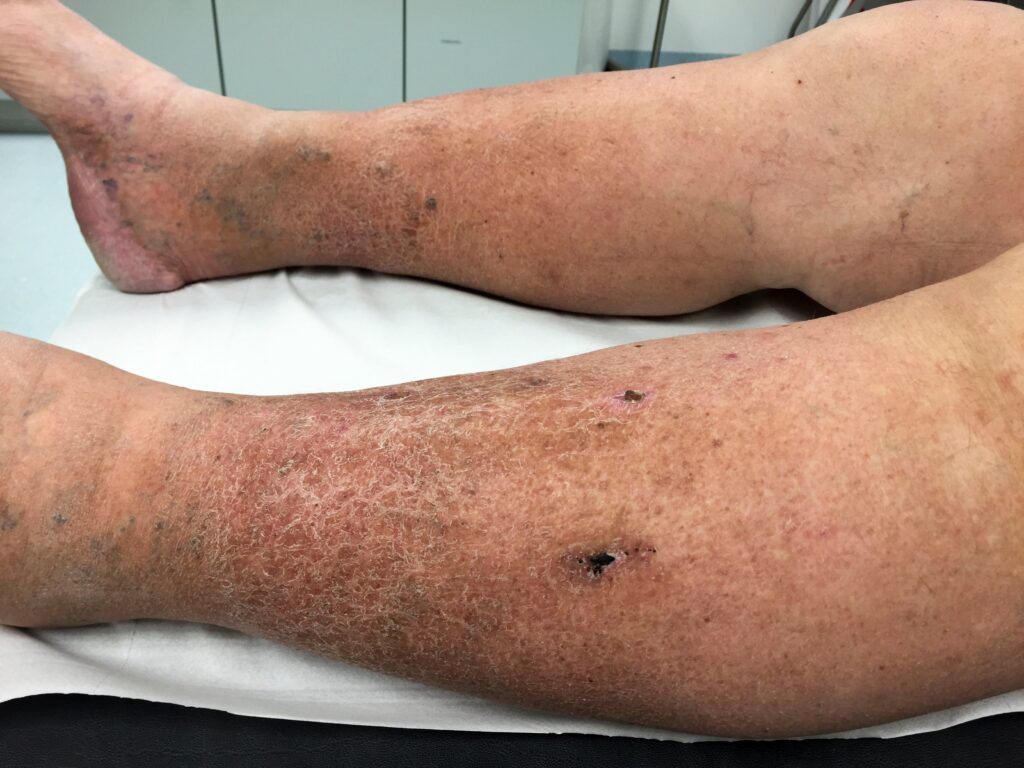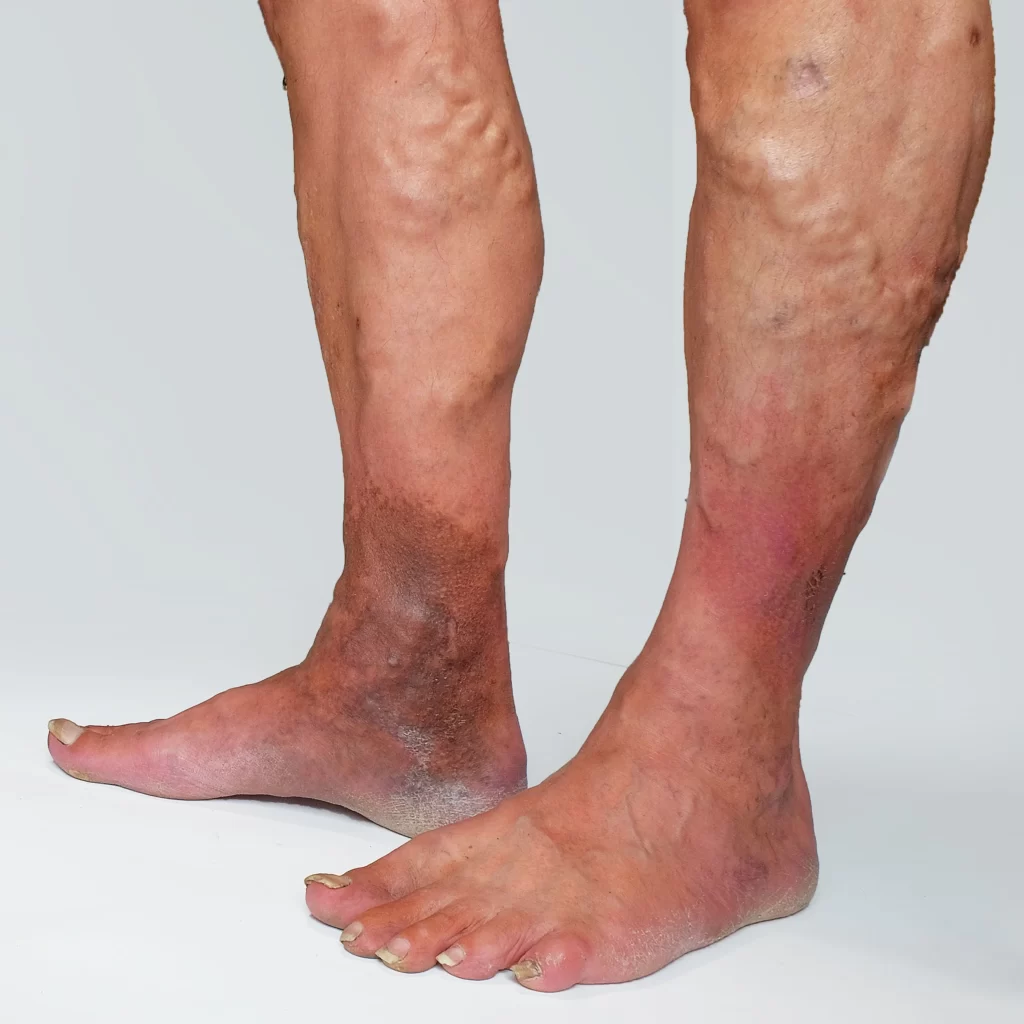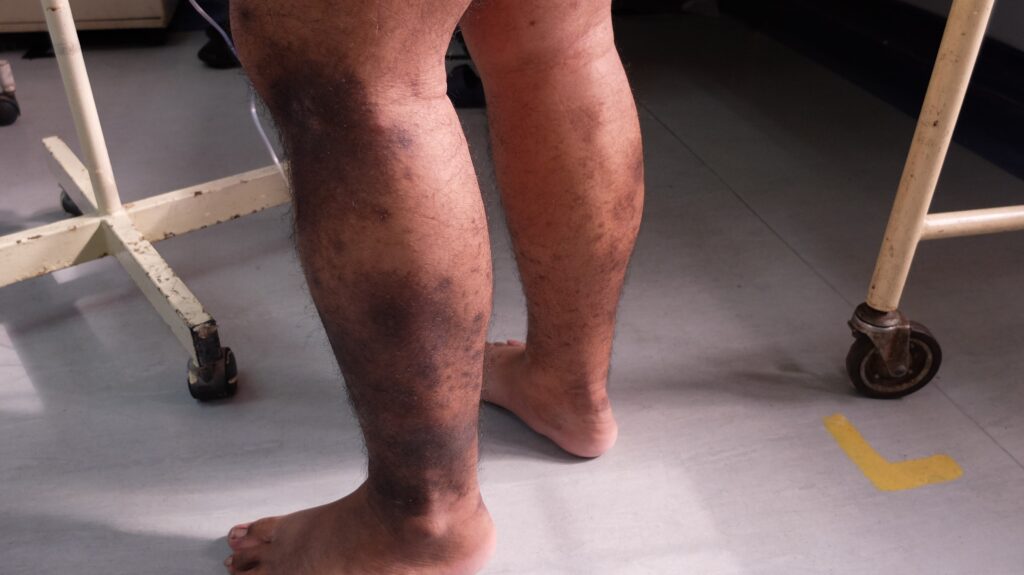
skin changes in Venous disease
At Laurel Clinical, we understand the journey of living with chronic venous insufficiency (CVI) and the toll it can take on daily life. It often leads to changes in the skin such as discoloration, thickening, and even ulcers. Our team is here to help by addressing both the underlying causes and the symptoms associated with CVI.

What Cause Skin Changes in Venous Disease?
In a healthy body, the veins in our legs work hard to carry blood back up to the heart, helped along by tiny valves that keep everything flowing smoothly in the right direction. But sometimes, these valves weaken or stop working as well, allowing blood to start pooling in the veins. This extra pressure on the vein walls and nearby tissues forces fluid to leak into the skin, causing inflammation, skin damage, and making it harder for wounds to heal properly.
Over time, these changes start to show up on the skin, bringing visible and often uncomfortable effects that can interfere with daily life. If left untreated, this can progress into pain, infections, and even open sores, or ulcers, that need intensive care. Seeking help early can make a big difference, easing symptoms and preventing complications down the road.
A Personalized Approach from the start
Our approach goes beyond symptom management to address the underlying causes and provide comprehensive, tailored care that supports long-term healing and well-being. We are committed to helping each patient feel informed, supported, and empowered throughout their treatment journey.
In our personalized approach to venous disease treatment, we begin with a thorough assessment to understand the specific symptoms and health factors each patient is experiencing. Using advanced diagnostics, we can identify the underlying issues contributing to skin changes, such as vein dysfunction or chronic inflammation
Beyond treatment, we place a strong emphasis on patient education and lifestyle support, knowing that the management of venous disease doesn’t end with clinical care. We work closely with each patient to guide them on daily practices that promote healing, from proper skin care routines to tips for enhancing circulation through activity and leg elevation. Our team remains available for ongoing support, providing follow-up care and guidance to ensure that our patients can maintain the results of their treatment and prevent future skin complications.
Metabolic Activity and the Microenvironment
In venous disease, the metabolic processes in the affected skin regions become disrupted due to reduced blood flow and oxygenation. Healthy skin requires a steady supply of oxygen and nutrients to support cell function and tissue repair. However, when blood pools in the veins, the skin’s access to these essential resources diminishes. This lack of oxygen and nutrient flow slows down cellular metabolism, weakening the skin’s ability to regenerate and respond to damage. Over time, this impaired metabolism leads to changes in skin texture, thickness, and appearance, as cells struggle to keep up with normal turnover and repair processes, leaving the skin more vulnerable to injury and slow to heal.
Alongside metabolic disruption, the microenvironment of the skin also undergoes significant changes in venous disease. When fluid leaks from high-pressure veins into surrounding tissues, it creates a moist, inflamed environment that fosters damage and swelling. This environment not only disrupts healthy skin function but also promotes chronic inflammation, which further degrades skin quality. Proteins, waste products, and inflammatory cells build up in the skin, causing discoloration, thickening, and a compromised barrier function. Together, these changes in the skin’s metabolic processes and microenvironment make it much harder for wounds to heal, leaving affected areas more prone to developing persistent sores or venous ulcers.
common skin changes
-
Discoloration
One of the first noticeable signs of venous disease is skin discoloration, especially in the lower legs. The skin may take on a reddish-brown or purplish hue due to blood pooling and iron deposits (hemosiderin staining) left behind from red blood cells leaking into the tissue. This discoloration can become permanent if not addressed early. -
Thickened and Hardened Skin (Lipodermatosclerosis)
As venous disease progresses, the skin around the ankles and calves may become thickened and hardened. This condition, known as lipodermatosclerosis, results from chronic inflammation and scarring in the tissue. The skin may feel tender and tight, making movement uncomfortable. -
Venous Ulcers
In severe cases, untreated venous disease can lead to the formation of venous ulcers—open wounds typically found on the lower legs near the ankles. These ulcers develop due to poor circulation and can be slow to heal. Without proper care, venous ulcers are prone to infections and may require ongoing medical treatment. -
Itching and Flaking
Chronic venous insufficiency can also lead to dry, itchy, and flaky skin due to poor circulation and the skin’s compromised ability to retain moisture. Scratching can worsen skin damage and increase the risk of infection, so it’s essential to manage these symptoms effectively.


ideal candidate
- Individuals with visible skin changes due to venous disease, such as discoloration, thickening, or ulceration
- Patients experiencing symptoms like itching, swelling, or persistent wounds on the lower legs
- Those diagnosed with chronic venous insufficiency or venous insufficiency symptoms (e.g., varicose veins)
- Patients who have pain or discomfort that affects their mobility or daily life
- Individuals who are committed to lifestyle changes, including using compression therapy and staying active
- Candidates seeking minimally invasive or regenerative treatment options to restore skin health
- Patients with realistic expectations and willingness for follow-up care to manage long-term skin health
our comprehensive Management approach
At Laurel Clinical, we craft a comprehensive, combined approach to treat patients with skin manifestations of disease, recognising that skin health is deeply connected to multiple underlying factors. Rather than focusing solely on the skin’s surface, this method addresses the haemodynamic, biological, and lifestyle aspects contributing to the condition. Haemodynamic health, which relates to blood flow and vascular health, plays a crucial role in delivering nutrients and oxygen to skin cells. By enhancing blood flow and supporting vascular health, the skin’s regenerative capacity is improved. Biological therapies focus on cellular health and immunity, targeting inflammation or imbalances at the core of many skin diseases.
This multidimensional approach proves significantly more effective than treating only the visible symptoms. By addressing all contributing factors, patients experience more comprehensive and sustainable improvements. Skin conditions often involve complex interactions between genetics, immune function, and environmental triggers; hence, focusing on only one area may lead to temporary or partial relief. Through Dr. Laur’s combined approach, patients benefit from a holistic treatment plan that not only resolves symptoms but also fortifies the skin against future flare-ups, ensuring healthier, lasting outcomes.
core components
Key features of our combination approach includes:
Minimally Invasive Intervention
By focusing on the underlying problem—poor circulation—these treatments improve skin health and reduce the chance of future complications. Procedures like sclerotherapy and endovenous laser ablation (EVLA) close off damaged veins, allowing blood to flow through healthier ones and relieving the pressure that causes discoloration, thickening, and even ulcers. With minimal discomfort and downtime, these treatments offer patients real relief and visible improvements in their skin, all while promoting long-term vein health.
Surgical intervention
For patients with ulcers that don’t respond to less invasive treatments, surgical intervention can be a valuable step toward healing. In these cases, procedures are carefully tailored to remove damaged tissue, improve blood flow, and create a better environment for the skin to repair itself. Surgical options may include skin grafts or venous surgery to address underlying circulation issues. While it may feel like a big step, these interventions are designed to relieve pain, promote faster healing, and help patients regain comfort and confidence in their daily lives.
topical treatment
Topical treatments play an important role in managing skin changes caused by venous disease, offering relief from symptoms like dryness, itching, and inflammation. Moisturizing creams and ointments help keep the skin hydrated and reduce flaking, while corticosteroid creams can be prescribed to calm inflammation and irritation in more severe cases. For discolored or thickened areas, medicated creams may assist in improving skin texture and appearance. Regular, gentle application of these topical treatments not only soothes the skin but also helps protect it from further damage, promoting overall skin health and comfort for those with venous disease.
medical Laser technology
Laser technology offers an effective solution for addressing skin changes and staining caused by venous disease. By targeting the pigments in discolored skin and damaged blood vessels, lasers help reduce visible redness, brown staining, and other pigmentation irregularities that often accompany venous issues. This process encourages the body to break down and absorb the unwanted pigment while stimulating collagen production, which can improve skin texture and resilience. Laser treatments are minimally invasive, with little to no downtime, making them a valuable option for patients looking to restore a healthier, more even-toned appearance to their skin.
Wound Care
Wound care management is crucial for patients with venous disease, as compromised blood flow can lead to chronic, non-healing wounds like venous ulcers. The foundation of wound care includes gentle cleaning, maintaining a moist wound environment with specialized dressings, and protecting the area from infection. For more severe or persistent wounds, advanced techniques like negative pressure wound therapy (NPWT) can be highly effective. This therapy uses a vacuum-assisted closure system that applies controlled suction to the wound, which helps remove excess fluids, reduce swelling, and improve blood flow to the area, creating an optimal healing environment. Combined with compression therapy and other supportive measures, NPWT and similar advanced approaches significantly enhance the healing process, offering patients relief from discomfort and reducing the risk of complications.
Regenerative Medicine
Regenerative therapies have shown significant promise in treating skin disorders associated with vein disease by accelerating healing and enhancing tissue repair. Platelet-Rich Plasma (PRP) therapy, in particular, has emerged as an effective treatment for stubborn ulcers and other skin manifestations caused by poor circulation. PRP involves isolating the patient’s own platelets, which are rich in growth factors, and injecting them into damaged skin areas to stimulate new cell growth, boost collagen production, and reduce inflammation. Studies have demonstrated that PRP can speed up the healing of venous ulcers by promoting wound closure and improving tissue quality, even in chronic cases where other treatments have been less effective. Beyond wound healing, PRP has been shown to improve skin texture, reduce discoloration, and strengthen the skin’s natural barrier. These benefits make regenerative therapies a valuable option for patients with vein disease, providing a minimally invasive approach to skin restoration and lasting relief.
Compression Therapy
Compression therapy is an essential part of treating skin diseases related to vein disease, as it improves blood flow and reduces venous pressure. By applying gentle, consistent pressure to the affected area, compression garments help prevent blood from pooling in the veins, reducing inflammation and promoting better oxygenation of the skin. This not only alleviates symptoms like swelling and discomfort but also supports the skin’s healing process by delivering nutrients more effectively
Prevention Tips for Maintaining Skin Health with Venous Disease
- Stay Active: Incorporating low-impact exercises, such as walking, swimming, or cycling, can improve circulation and support vein health.
- Elevate Your Legs: Elevating the legs above heart level several times a day can reduce swelling and relieve pressure in the veins.
- Wear Compression Stockings: If you have been advised to wear compression stockings, follow the guidelines to maximize their effectiveness.
- Moisturize Daily: Keeping the skin hydrated can help reduce dryness and prevent irritation, especially if you experience itching.
- Limit Salt Intake: Reducing sodium in your diet can help control swelling by decreasing fluid retention.



